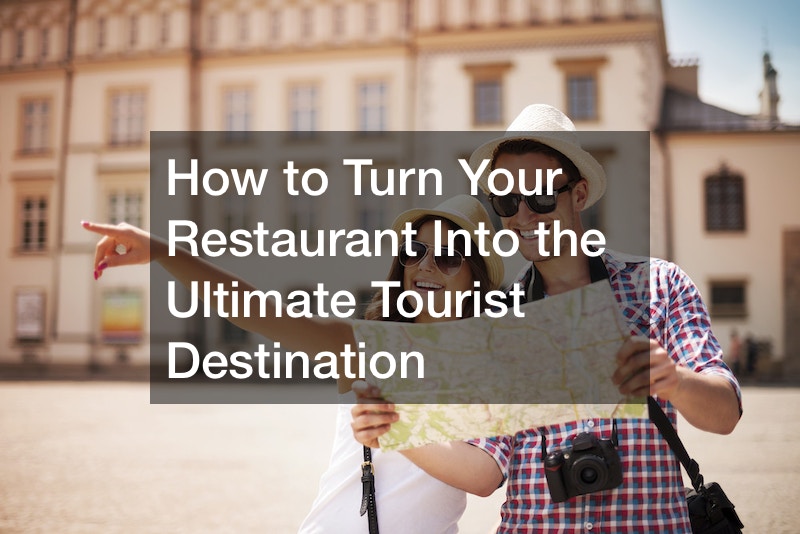
If your restaurant’s initial marketing strategy was to create a stir in the neighborhood by engaging regular foot traffic and return customers from the locality, it’s time to consider food tourism travelers. With the right approach, you can expand beyond local outreach and find a way to spark interest from people outside your community. These tips will help you turn your restaurant into the ultimate tourist destination.
1. Landscape Your Restaurant

First impressions have a lasting impact. One of the first visual impressions your customers have is from your landscaping. Why not make it lovely and inviting? Even if your customers don’t express it out loud, they’ll still admire the scenery outside your restaurant.
Food tourism enthusiasts typically want to experience the local culture during their travels. Your landscaping offers a great opportunity to introduce cultural aspects of the area. A landscape designer can help you create your dream surroundings while incorporating cultural aspects to beautify the space.
Add some greenery to the entrance of your restaurant. Your clients will feel more at ease and more receptive to the culinary delicacies to come, even if all you have room for is a few basic planters to either side of the front door. Ask your landscape designer to add calming plants to provide the perfect ambiance.
People will gravitate toward the friendlier view, especially those into food tourism because tourists are probably tired and unfamiliar with the area. You can also incorporate water features such as small waterfalls or koi ponds. Remember to factor in the regular maintenance of whatever landscaping you decide on to ensure it’s manageable.
2. Restaurant Lighting
Your restaurant lighting can be the difference between your customers having a good or bad dining experience. Remember to pick and install lighting according to its function. Get licensed electricians to do the installations.
Check their credentials and talk to their previous clients to ensure you’re getting quality services. For ambient lighting, the restaurant’s main lighting source, start by maximizing natural light. However, unique electric overhead fixtures can suffice.
You want to provide your tourists with the best meals. Since in food tourism, some travel bloggers may write reviews on your meals, ensure that you use bright fluorescent lighting in your kitchen. This task lighting will ensure no sugar is added instead of salt, among other avoidable mistakes.
Accent lighting inside the restaurant will set the tone for the evening dinners. If you have a bar top, you can incorporate decorative island lights. You can also use accent lighting to highlight decors and wall art in the space
Your restaurant’s outside should be part of the dining experience. It acts as a draw and advertisement. Adding lighting will help showcase the building’s architecture and illuminate eating areas when natural light is low.
3. Menu Planning

Think of any famous food chain. Realize how the consistency of one thing has made them famous and a household name. Customers love some level of beforehand planning and consistency. That’s why having a restaurant menu is of the utmost importance.
It’ll encourage food tourism because your customers are probably new in the area, and a simple recommendation such as, ‘This restaurant has the best tacos in the area’ will be a great marketing plan by word of mouth.
Another great way of turning your restaurant into the ultimate tourist destination is by providing more menu specials. It can be happy hour, seasonal, or breakfast specials. Most specials are unique and limited, which makes their demand go high.
Offering promotions in the form of specials is a fantastic way to interact with your clientele, promote a sense of neighborhood, and increase restaurant sales. Additionally, it will allow the cooks to express their creativity and keep the restaurant adaptable and free from ruts.
Make sure you provide all your customers with menus to decide what they will have. Simplicity is the key here. Don’t make it too hard for them to figure out their order or the accompanying prices, as good service will go a long way to earn you a good review.
Practice menu planning and managing with your staff. This will help you plan, stock, and test the various types of dishes before incorporating them into your menu. Your menu plan, which functions as a blueprint for what dishes you serve, will assist the food service manager in creating menu items that appeal to customers and bring in money.
4. Hygiene In Your Restaurant
To invest in food tourism and elevate your restaurant to attract more tourists, you will require top-notch customer service. Customer service includes maintaining cleanliness. Having a tidy eating space for each guest is just as vital as the quality of the food. It demonstrates your concern and desire for your customers’ satisfaction while dining.
Due to how sensitive the food industry is, a bad review on your hygiene levels written by any tourist customer is enough to ruin your reputation. For a good first impression and customer loyalty, ensure a clean establishment. If your restaurant is untidy, it will poorly reflect how you conduct the rest of the business. A filthy establishment raises worries about the management of the restaurant as well as doubts about the safety of the food. Customers can start to form doubts regarding the management’s concern for the well-being of their clients and staff.
One way to show your commitment to your restaurant’s hygiene and overall health is hiring restaurant hood cleaning services for regular clean up. Observe the food hygiene guidelines on routinely cleaning and disinfecting the different areas of your restaurant. To prevent transmitting dangerous infections, frequently sterilize surfaces such as those used for food preparation, dining places, door knobs, and many other locations.
Nobody wants to be concerned about contamination from the people handling their food. Customers select one restaurant over another based on the cuisine, the type of services, the ambiance, and the general hygiene observed in the restaurant. Prioritize these to retain your clientele and build a solid reputation.
5. Update Your Restaurant

Like with every other thing, updating your space via renovation will elevate your services and make restaurant operations more efficient. However, renovating your restaurant kitchen can be quite costly. So first, decide on your budget, then get a kitchen remodeling company with whom you can work hand in hand to deliver a modern kitchen within your budget.
Before you start creating designs, measure the kitchen space. The question of space is important because you don’t want to have a cramped kitchen. Along with those considerations, you also need to consider electrical outlets, fire escape doors, and windows.
Invest in energy-efficient kitchen appliances to lower your energy bills. Commercial kitchens typically consume a lot of energy via cooking and HVAC. To maximize efficiency, pay attention to how you set up this equipment. Place your cold storage equipment, for instance, far from your cooking areas so that your refrigerators won’t have to work harder to make up for the excess heat.
6. Water Provision In Your Restaurant
You can’t have a hygienic space without a proper water system, and you can’t have an efficient water system without proper plumbing. So, as you work to elevate your restaurant to be recognized by food tourism customers, ensure a steady and dependable water supply. You need this basic amenity for everything from cooking to cleaning kitchen utensils. A restaurant requires a properly operating water supply system to uphold food safety requirements and offer their diverse customers the first-rate service they demand.
Compromised plumbing can quickly escalate to a million other problems. Low water pressure will result in slow service while leaking taps will lead to wastage. Leaking pipes will cause molds and compromise the interior.
Burst pipes may result in full-on flooding and lead to an embarrassing ordeal. Call your local plumbers when you notice signs of plumbing issues. You can have them on a retainer so they can conduct regular maintenance.
7. Improve Your Restaurant Outdoors

Revamping your restaurant patio will do wonders for attracting food tourism customers. People want to travel and take photos in aesthetically pleasing spaces. If your patio has cool and unique designs, it’ll attract tourists easily.
Scout for the best construction companies to help you design and build features like sidewalk seating and a front or back patio for your restaurant. Consider how you want to use the area and adjust your design accordingly. Choose if you want it to be used only for dining and seating or if you want to include other attractions like interactive features or warm couches with fire pits. Rooftop bars are lovely for the summer holidays.
Adding signage is also a great way of revamping your outdoor spaces. Consider investing in a digital sign. It’ll serve an aesthetic and functional purpose by allowing you to customize your messages to promote happy hour at the bar or dinner, lunch, and breakfast specials. Customized marketing messages will make your efforts to attract customers more effective.
Whether you choose a sleek, contemporary design or a retro neon sign, make sure it complements the concept and ambiance of your restaurant. You should also ensure your signage is well-lit for nighttime visibility and so that it’s visible from a distance. Only use quality materials so your sign can endure the elements and keep its charm over time. Keep in mind that potential clients frequently notice your sign first, so get it right.
8. Use Quality Materials
Passersby frequently get their initial impression of a restaurant from its storefront. Potential consumers might avoid a restaurant if its storefront appears unsightly, cheap, or badly constructed and instead visit other, more appealing eateries. That’s why you should always use quality materials.
There are many possibilities for a stunning storefront. The glass you use at the entrance is a great place to start. Work with professional storefront glass services to choose the best one for your establishment. A glass storefront will enhance the visual appeal of your restaurant and make the space feel bigger.
9. Get Cleaning Supplies
To keep your restaurant clean, you must invest in commercial cleaning supplies. The market is saturated with these products, so take your time to research to ensure you purchase the best products. Identify what you need for sanitizing, cleaning, and disinfecting before placing orders.
You and your staff must be extra careful while handling the cleaning products. Some of them, like bleach or chlorine, have toxic substances. Even if a product is labeled as mild, keep it away from food.
Be sure to provide your staff with all the necessary cleaning equipment to ensure optimal hygiene levels in the establishment. Have a manager routinely inspect the cleanliness of the washed utensils because customers pay attention to the state of the cutlery and crockery they’re served with.
The food tourism industry was especially derailed due to the pandemic. However, this also brought extreme precautions, such as mandatory sanitization, which have become the new norm. Be keen not to contaminate foods with even sanitizers because they’re not safe for ingestion.
10. Promote Your Restaurant
After liaising with a commercial building service in your area to ensure you have achieved the intended outcome of your restaurant and are at par with repair and maintenance, the ball is now in your court to bring in customers. Avoid clichés and gimmicks like giving souvenirs. Instead, look for what feels authentic to your local area and use it to provide an experience of a lifetime.
Partnering with social media influencers with audiences that relate to your brand can help promote your restaurant. Look for travel lifestyle influencers whose content revolves around displaying new resort amenities, talking of a vacation to a new location, and food bloggers finding and testing new cuisines or promoting new restaurant specials.
Participate in food tourism activities as much as possible. Attend any local events held to draw tourists. This includes events held by public institutions and commercial businesses and festivals or national celebrations.
Even as you try to attract more foreigners to your restaurant, don’t underestimate the power of your local appeal. The food tourism customers want to experience the culture of your area through the food locals enjoy there. Following the tips above, you can transform your hotel into a tourist destination.



